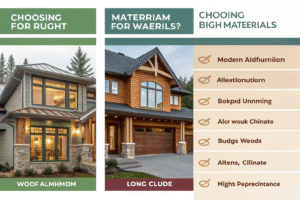Color adds personality and protection to aluminum windows — transforming plain metal frames into beautiful, weather-resistant architectural features. Whether you prefer a bold contemporary tone or a subtle natural finish, the right coloring method ensures lasting beauty, durability, and corrosion resistance.
There are several ways to color aluminum, each offering distinct textures, lifespans, and design effects.
Here’s a detailed guide to the four most common methods used to apply color to aluminum windows — and how to choose the one that fits your design and performance needs.
Powder Coating — The Most Popular and Durable Method
Powder coating is the most widely used technique for modern aluminum windows.
It involves electrostatically applying dry powder paint to the aluminum surface and then baking it at high temperature to form a hard, colorful finish.
Key Features:
| Aspect | Description |
|---|---|
| Finish Type | Matte, gloss, or textured |
| Durability | 20+ years (weather & UV resistant) |
| Color Options | 200+ RAL shades |
| Maintenance | Easy to clean, no peeling or fading |
Powder coating not only enhances appearance but also provides excellent protection against corrosion, scratches, and harsh weather.
At our factory, we use AkzoNobel and PPG powder coatings baked at 200°C for a consistent, long-lasting finish that stays vibrant for decades.
Best For: Modern homes, commercial buildings, and coastal areas needing strong UV and corrosion protection.
Anodizing — Metallic Shine with Long-Term Durability
Anodizing is an electrochemical process that thickens the natural oxide layer on aluminum, creating a smooth, metallic finish.
It offers excellent resistance to corrosion and fading, with a unique, elegant sheen that enhances architectural designs.
Advantages:
- Exceptional surface hardness and weather resistance
- Natural metallic appearance (silver, bronze, black, champagne)
- Resistant to UV and salt corrosion
- Ideal for minimalistic, modern designs
We use Type II and Type III anodizing methods, offering both decorative and hard-anodized finishes — perfect for high-end residential and commercial window systems.
Best For: Projects that value metallic texture, durability, and a natural aluminum aesthetic.
PVDF Coating — Premium Finish for Extreme Environments
PVDF (Polyvinylidene Fluoride) coating is a high-performance liquid paint finish applied using spray coating, then cured for superior durability.
It’s known for outstanding resistance to UV rays, acid rain, and coastal corrosion, making it a premium choice for large façade projects.
Key Benefits:
| Feature | Advantage |
|---|---|
| UV Resistance | Excellent for outdoor use |
| Gloss Retention | Maintains color for 25+ years |
| Surface Feel | Smooth, rich texture |
| Environmental Stability | Ideal for tropical and coastal regions |
We use Kynar 500® PVDF paint systems, certified under AAMA 2605 standards, ensuring long-term weather protection and color integrity in even the harshest environments.
Best For: High-rise buildings, coastal homes, and projects requiring superior fade resistance.
Woodgrain Transfer or Sublimation — Natural Look, Modern Performance
For homeowners who love the warmth of wood but need aluminum’s strength, woodgrain transfer (also called sublimation printing) is the perfect solution.
This method uses heat and pressure to transfer a wood pattern onto powder-coated aluminum, creating a realistic timber look.
Key Features:
- Replicates oak, walnut, teak, or custom grain patterns
- Retains all aluminum durability and weather resistance
- Long-lasting, scratch-resistant finish
- Low maintenance — no warping, cracking, or repainting
We use Italian sublimation film technology with UV-stable inks to ensure deep color penetration and realistic texture — ideal for villas, residential projects, and boutique interiors.
Best For: Homeowners who want the charm of wood with the lifespan and stability of aluminum.
How to Choose the Right Coloring Method
When selecting a color application method, consider environment, design goals, and budget.
| Method | Durability | Appearance | Cost | Ideal Use |
|---|---|---|---|---|
| Powder Coating | ★★★★★ | Matte/Gloss | $$ | General residential & commercial |
| Anodizing | ★★★★☆ | Metallic | $$$ | Modern minimalist projects |
| PVDF Coating | ★★★★★ | Smooth high-gloss | $$$$ | Coastal or extreme weather |
| Woodgrain Transfer | ★★★★☆ | Natural wood look | $$$ | Residential or villa designs |
At our factory, we help clients select finishes that balance performance and style — using environmentally friendly coatings and advanced finishing technology for lasting results.
Environmental Benefits of Modern Coating
All four coloring methods today are designed with sustainability in mind.
They use non-toxic materials, low-VOC emissions, and recyclable aluminum bases — minimizing environmental impact.
We operate under ISO 14001 and RoHS standards, ensuring that every aluminum window we produce is safe, durable, and eco-friendly.
Conclusion
Coloring aluminum windows is about more than aesthetics — it’s about protection, performance, and personality. From sleek anodized metallics to warm woodgrain textures, modern color application methods offer limitless possibilities with exceptional longevity.
At our factory, we specialize in custom-colored aluminum window systems using powder coating, anodizing, PVDF, and sublimation technologies. Every frame is crafted with precision, tested for durability, and designed to complement your space perfectly.
Contact us today to discover your ideal aluminum window finish.
Let’s create windows that look stunning, last decades, and reflect your unique style.

